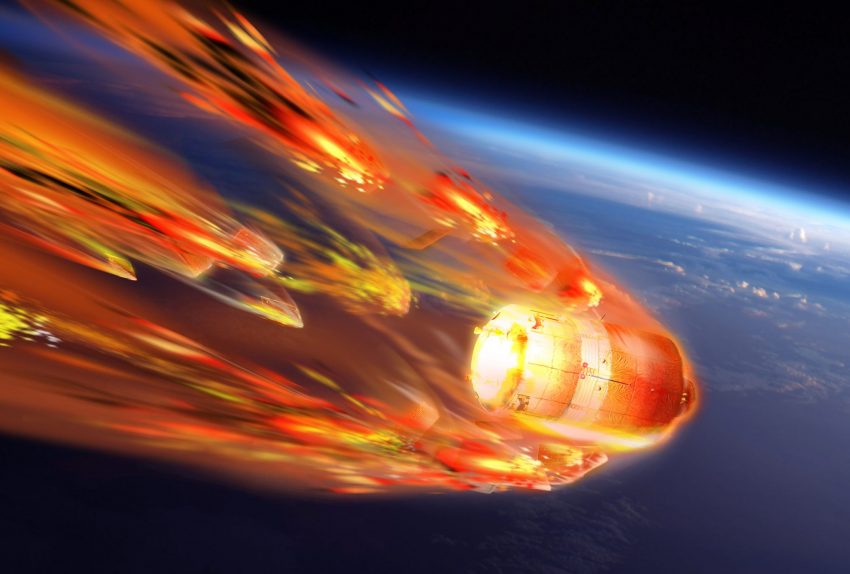Burned-up satellite debris could deplete ozone layer Leonard Schulz in an interview about satellite debris and its impact on the atmosphere
It’s like a new space race: in order to connect the world with faster internet, more and more companies are planning to launch numerous satellites into space every year in the form of mega-constellations. The consequences for our atmosphere have so far been insufficiently considered. Leonard Schulz, a doctoral student at the Institute of Geophysics and Extraterrestrial Physics at Technische Universität Braunschweig, is working with Professor Karl-Heinz Glaßmeier to fill this research gap. In this interview, Schulz talks about a new line of research and the dangers to the ozone layer.
What problems are caused by space debris? Which ones have you investigated?
When it comes to space debris, there are basically three levels of problems. First, there is the problem of orbit. An orbit is the path of a satellite around a larger celestial body. If satellites collide or are damaged in orbit, chain reactions can render entire orbits unusable. The material must therefore be disposed of. There are so-called graveyard orbits, such as distant geostationary orbits, to which satellites can be launched for disposal. However, this option cannot be used in low-Earth orbit because all the available orbits are already too full. The only alternative is to allow the satellites to re-enter the atmosphere, but this creates further problems.
Secondly, there is the ground problem, which means that re-entering pieces could hit inhabited areas and fall on our heads. To avoid this, attempts are being made to burn up satellites in the atmosphere or to sink them in uninhabited sea areas. There are detailed studies and regulations for both of these problems. The companies have to make sure that nothing falls on our heads and that the satellites do not remain in orbit uncontrolled.
Thirdly, there is the atmospheric problem. When the material burns up, it does not disappear, but residues remain in the atmosphere. Very little research has been done on the effects of this on the atmosphere and how much of it actually remains in the atmosphere. Professor Glaßmeier and I have taken this as an opportunity for our research work, and in doing so we have virtually co-founded a new field of research.
How did you go about it?
Our first aim was to analyse the incoming material and compare the proportion of anthropogenic (man-made) material that enters and remains in the atmosphere with natural material. Natural material includes meteoroids, which are dust particles and larger pieces of rock from the solar system that burn up when they enter the atmosphere, for example in the form of shooting stars. Until now, experts have assumed that the man-made fraction is so small compared to the natural material that it can be neglected. However, our initial calculations have shown that it is in fact several percentage points.
In a paper, we were able to show that in 2019, the anthropogenic mass that entered and remained in the atmosphere was three per cent of the natural mass. So for every 100 kilograms of natural mass, there are three kilograms of anthropogenic mass. That doesn’t sound like much, but it’s not negligible. And remember: that was in 2019, and a lot has happened in space since then.
SpaceX’s Starlink satellite network alone has launched 6,000 satellites in the last five years – mega-constellations long thought impossible. We have taken these new developments as an opportunity to create future scenarios. If 10,000 satellites with a lifespan of five years are regularly launched into space, this means that practically every five years 10,000 satellites enter the Earth’s atmosphere and burn up. Extrapolated, this means that the proportion of anthropogenic material in the atmosphere is no longer “only” three per cent, but in the worst case 40 per cent. If we consider only those metals that are proportionally much more abundant in anthropogenic material than in meteoroids, or that have a much larger mass fraction, then in our worst case scenario we are already at almost the same injection, at 90 per cent. In the case of aluminium, we are already injecting even more anthropogenic mass into the atmosphere than from meteoroids. All this shows that the anthropogenic fraction is significant and should not be neglected.

Table: Mass of anthropogenic injection in the atmosphere (compared with natural injection). Table credit: Leonard Schulz/ Institute of Geophysics and Extraterrestrial Physics
These figures are estimates. How realistic are they?
Of course, there are always uncertainties with such estimates. But our figures were confirmed last year by observations made by colleagues in the USA. They collected dust particles in the lower layer of the atmosphere, the stratosphere, near the North Pole and analysed them using a mass spectrometer. Because of atmospheric currents, it is also possible to obtain information about higher atmospheric layers at the North Pole in winter. During the same studies, it was discovered by chance that a significant proportion of the dust particles came from satellite debris or similar sources, i.e. were man-made. In the case of aluminium, for example, it was 70 per cent. And that is quite consistent with our estimates. It really is a real phenomenon that could cause problems in the future.
What problems would that be?
The main problem is that we have no idea. The atmosphere is an incredibly complex structure with different layers that all behave differently. There are also many unanswered questions about the material. We don’t know at what altitude the burnt material is introduced, what state it is in, how large the particles produced are, and so on. So we cannot make any predictions about the consequences.
What we can say is this: There is a realistic possibility that the material in the atmosphere is destroying the ozone layer. Certain clouds, known as polar stratospheric clouds, play a role in ozone depletion in the stratosphere. If more dust particles or certain aerosols are released into the atmosphere by burning, these clouds may form more frequently and destroy more ozone. These are catalytic effects, which means that even small amounts can have a large impact. In addition, some of the substances in the re-entering material, such as bromine and chlorine, are themselves destructive.
It could also affect the climate and generally increase cloud formation in different layers of the atmosphere. The penetration of material into the atmosphere could therefore lead to major problems, and yet this aspect has been completely neglected. We are currently conducting an uncontrolled experiment by releasing large quantities of vitrified material into the atmosphere on the basis of “let’s see what the consequences are in ten years’ time”. Climate change and plastic pollution in the oceans have shown that this approach can be very problematic. So we had better act now, before we irreparably damage our atmosphere.

Doctoral student Leonard Schulz. Photo credit: Institute of Geophysics and Extraterrestrial Physics/TU Braunschweig
How can we tackle the problem of space debris?
Basically, the only way to solve all three of these problems is to put fewer satellites in space. We need to find out: How many satellites can we put into space without harming the environment? What are the limits? How can we use the satellites most effectively? We have to find the right balance between harm and benefit, because satellites and mega-constellations are fundamentally very helpful, improving our global Internet, for example. However, the geopolitical situation reinforces the need for a large number of satellites in space. If companies from the US send mega-constellations into space, China wants to do the same. This means that we could end up with ten different constellations of satellites in orbit for the global Internet, all doing the same thing, rather than building and using a common infrastructure. Global cooperation to minimise the number of satellites in space would be desirable.
Are there any alternatives?
What could also help is to increase the lifetime of satellites. This would result in less space debris over time. To solve the atmospheric problem, research could be carried out to see what materials can be used that are less harmful to the atmosphere. Or satellites could be designed so that when they burn up, they produce fewer small aerosols and more larger particles that quickly sink to the ground. These are all approaches that could be considered to improve the situation to some extent.
But to solve this problem, we need scientists from other research disciplines and industry. In principle, I would like to see science, industry and politics working more closely together to find out how to make commercial space travel more sustainable. It might also make sense to set up an international body to discuss these space issues and establish rules.

